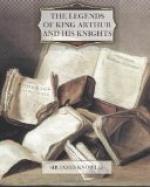ILLUSTRATOR’S NOTE
Of scenes from the Legends of King Arthur and his Knights of the Round Table many lovely pictures have been painted, showing much diversity of figures and surroundings, some being definitely sixth-century British or Saxon, as in Blair Leighton’s fine painting of the dead Elaine; others—for example, Watts’ Sir Galahad—show knight and charger in fifteenth-century armour; while the warriors of Burne Jones wear strangely impracticable armour of some mystic period. Each of these painters was free to follow his own conception, putting the figures into whatever period most appealed to his imagination; for he was not illustrating the actual tales written by Sir Thomas Malory, otherwise he would have found himself face to face with a difficulty.
King Arthur and his knights fought, endured, and toiled in the sixth century, when the Saxons were overrunning Britain; but their achievements were not chronicled by Sir Thomas Malory until late in the fifteenth century.
Sir Thomas, as Froissart has done before him, described the habits of life, the dresses, weapons, and armour that his own eyes looked upon in the every-day scenes about him, regardless of the fact that almost every detail mentioned was something like a thousand years too late.
Had Malory undertaken an account of the landing of Julius Caesar he would, as a matter of course, have protected the Roman legions with bascinet or salade, breastplate, pauldron and palette, coudiere, taces and the rest, and have armed them with lance and shield, jewel-hilted sword and slim misericorde; while the Emperor himself might have been given the very suit of armour stripped from the Duke of Clarence before his fateful encounter with the butt of malmsey.
Did not even Shakespeare calmly give cannon to the Romans and suppose every continental city to lie majestically beside the sea? By the old writers, accuracy in these matters was disregarded, and anachronisms were not so much tolerated as unperceived.
In illustrating this edition of “The Legends of King Arthur and his Knights,” it has seemed best, and indeed unavoidable if the text and the pictures are to tally, to draw what Malory describes, to place the fashion of the costumes and armour somewhere about A.D. 1460, and to arm the knights in accordance with the Tabard Period.
Lancelot speed.
LIST OF ILLUSTRATIONS
The Marriage of King Arthur
Then fell Sir Ector down upon his knees upon the ground before young Arthur, and Sir Key also with him.
The Lady of the Lake
The giant sat at supper, gnawing on a limb of a man, and baking his huge frame by the fire
The castle rocked and rove throughout, and all the walls fell crashed and breaking to the earth
Came forth twelve fair damsels, and saluted King Arthur by his name




